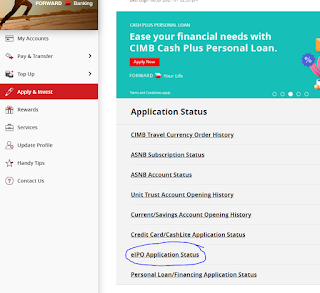Share Margin financing is a
convenient facility offered to traders seeking to expand their trading
potential or for investors to leverage on their positions. Maybe some of you
have yet to hear about this product, but this is not something new in the Stock
Market. It is available to all eligible Malaysians, Residents and Non-Residents
who have sounds financial standing.
This facility can be provided by
conventional bank as well as broker/Investment bank. It is very common that 2
different entities in the same group (Example: RHB bank vs RHB Investment Bank)
provide the facilities with different term and conditions.
This is because each of them is
bound by different regulation where conventional bank was regulated by Bank
Negara Malaysia (BNM) whereas Investment bank is regulated by Securities
Commission (SC).
In essence, this is a loan facility to
leverage on your new/existing stock holding position. Market participants can
use Share Margin Financing as additional funding to purchase shares quoted or
to be quoted on Bursa Malaysia.
As we know there are someone will
finance their stock purchase by using some financing tools provided by the Bank
for example like OVERDRAFT facilities. However most of the Overdraft charge you
the rate of around 5%-7% and share margin will only charge you around 4.65%-4.85%.
If you are holding a share that you will not be selling off no matter what
price it is, you can actually transfer into margin account by pledging as
collateral and withdraw the cash anytime whenever you need some cash.
Below Table show the difference
if you Finance to buy share using Overdraft
Financing /Monthly Interest
|
Share Margin Financing
4.85%
|
Overdraft
7%
|
Saving
|
100,000
|
RM404
|
RM583
|
RM179
|
500,000
|
RM2020
|
RM2917
|
RM897
|
1,000,000
|
RM4040
|
RM5833
|
RM1793
|
There are a few important terms that
you should know before you apply share margin financing as below:
When Application:
TERMS
|
DESCRIPTION
|
Document
|
Photocopy of IC;
1 of the following document:
Ø
CDS Statement from Bursa
Ø
Latest 3 months bank statement(With salary
detail)
Ø
Latest 3 months salary slip
Ø
Latest Tax document(B/BE/EA)
|
Drawdown facilities
|
Usually bank will have financing
amount of at least RM50,000
|
Stamp duty
|
0.05% of financing amount
|
Interest rate
|
BLR- X%(1.5-2.5%) or Base Rate
+ X% rate
|
Fees And charges
|
Rollover fees, Committement
fees, annual renewal fees, cash withdrawal charges, Nominees charges
P/S:
Most of the bank will waives all kind of abovementioned charges except
Nominees charges(corporate action fees) .
|
Before Trading:
Accepted Collateral
|
In a form of Cash/ FD/Listed
Securities
|
Limit
|
= Cash/FD x 2.5 or Securities x
1.5 (Depend on the Bank Marginable percentage on respective securities &
cannot exceed financing amount )
|
When Trading:
There will be a different
calculation method for the Margin ratio but all should practice the same
concept.
Security Coverage = Equity Value_________ x 100%
Current Outstanding Balance
TERMS
|
DESCRIPTION
|
Share Margin Financing ratio
|
Some bank will call it Margin
of advance, Margin of Finance(MoF), which is your current Financing status
/Security Coverage Ratio
P.s
: Some lenders calculate margin of finance using an inverse of the above
formula.
|
Margin Call Ratio:
|
Below 150% (<150%)
|
Force Selling trigger Ratio :
|
Below 130% (<130%)
|
Withdrawal Request Minimum
ratio
|
Cash Withdrawal =<167%
Securities Withdrawal =<200%
|
Scenario 1(Financing/Loan Amount = RM 150,000)
Investor A Profile
Ø
Collateral = RM50,000 (Cash /FD)
Ø
Limit Can be utilize = 50,000 x 2.5 = RM125,000
If Fully utilize the RM125,000
Securities
Coverage = _________RM125,000 (Total securities value) x 100%
RM125,000 (Total utilized loan) -
RM50,000(Colleteral)
Margin Call =<150%
You will be on margin call when
your share drop below RM112,500
(Use your outstanding balance
times the ratio –> RM75,000 * 150%)
Force selling = <130%
Same calculation here which mean
you will need to rectify your account when your Equity Value drop below RM 97,500
P.s
: Please always consult your dealer /Remisier if you have the difficulty on
calculate this ratio.
Above is the common thing that an
investor shall know when they open a share margin account. However,I would like
to highlight another benefit of using Share Margin Account which might not be known
to all investor.
Let me show you how this thing
works.
Scenario 1-Investor B Profile
Ø
Collateral = RM60,000 (Public bank 3,000 unit @RM20.00)
Ø
Limit Can be utilize = 60,000 x 1.5 = RM90,000
You can choose to buy additional RM
90,000 worth of stock based on your collateral (Please bear in mind you might
get margin call if both your PBB and new purchase is dropping)
Or you can withdraw cash based on
your collateral. (In this cash PBB shares) (All price movement and corporate
action including dividend still belong to you)
Securities
Coverage = RM 60,000 __
x 100% = 167%
RM 35,925
The outstanding amount is
RM35,925 and mean you could withdraw maximum up to this number out for your own
usage and bank will charge you interest on your withdrawal amount as well.
How margin call work
Investor B Profile
Ø
Collateral = RM60,000 (Public bank 3,000 unit
@RM18.00)
Ø
Limit Can be utilize = 54,000 x 1.5 = RM81,000
Securities
Coverage = RM 54,000 __
x 100% = 167%
RM 32,335
You will have to top up
RM35,925-32,335 = RM 3,590 within 3 days grace period.
In Summary, this is a flexible
facility that allows you to withdraw the cash and look for some higher return
investment without selling your share or utilize it to repay your debt which
charges you higher interest rate.
This is a guest post contributed by Martin Heng Sin Soon, an Equity Dealer with RHB Investment. You may contact him via martinheng87@gmail.com







